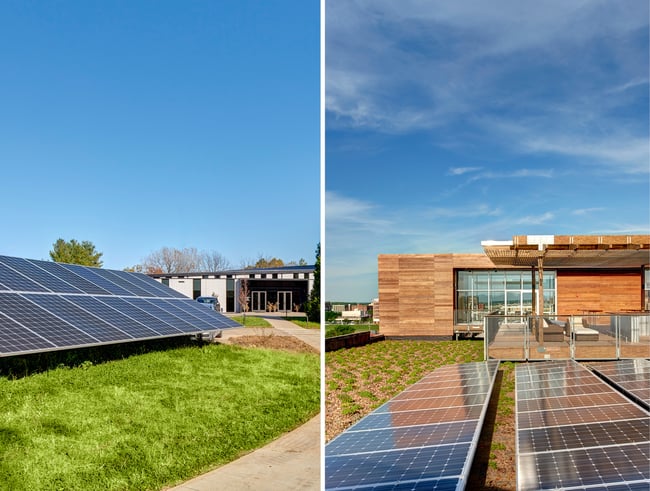How to Prepare for Solar Power on a Building Project

If you are planning a building project, you may be considering solar power. This investment can be an effective way to lower your carbon footprint and operating costs, and with more financial incentives available, it is more feasible than ever.
Our team has integrated solar power into several projects, including Market One, Iowa City Public Works, and the Stanley Center for Peace and Security. In our experience, successfully incorporating solar requires careful preparation and research.
This article will discuss how to prepare for solar installation and get the most out of your investment. Even if solar is not financially feasible during your project’s initial construction, following these steps will put you in an advantageous position for future installation.
4 Ways to Prepare for Solar Power
1. Reduce Your Energy Load
On-site energy production should be the last step in a sustainable design framework. Before adding solar power, your design team should work to improve the building’s performance and reduce its energy load.
Early design moves like selecting the right site, orientating the building for passive solar exposure, and using performance modeling can go a long way in reducing your building’s energy consumption. Other moves like increasing insulation can reduce the likelihood of drafts and maintain more consistent interior temperatures throughout the year.
We also recommend electrifying your mechanical system to take full advantage of on-site energy generation. Making strategic design decisions will reduce the number of photovoltaic (PV) panels you need to power your building.
2. Determine How Much Power You Need to Produce
The second step of preparing for solar installation is determining how much energy you want to produce. Some building owners want to produce a portion of their power through solar, while others want to achieve net-zero energy. These goals should be discussed with your design team and solar provider, so they can determine how many panels you will need.
Some utility providers use a billing arrangement called net metering to encourage renewable energy adoption. With net metering, surplus energy produced by your panels is sent to the grid, and you receive credits that offset your energy costs during periods of lower solar production.
These policies vary by location, and there may be specific rules for using energy credits. When net metering is not available, the general rule is to not overproduce energy. Since energy is sold back to building owners at a higher rate than the utility provider buys it, surplus energy production provides no financial benefit.
Another option is to add a battery system. Batteries can be used when power outages occur, making your building more resilient.
3. Assess Your Roofing System
Roofing systems can impact a PV array’s installation, maintenance, and longevity. If you choose to install a rooftop array, your design team should help you understand the benefits and drawbacks of each system.
While cost-effective, shingle roofs require mounting systems for PV panels. They also have a limited lifespan and will likely need to be replaced before the panels. In these situations, the panels will need to be removed and reinstalled.
Low-slope, membrane roofs allow for easy installation and maintenance but may also have a shorter lifespan than PV panels. Panels should be installed within five years of a new roof or planned with a replacement project to minimize the potential of replacing the membrane before the end of the panels’ warranty.
Metal roofs, on the other hand, require a large upfront investment but are highly durable and can outlast a solar array. Your design team can help you weigh these options and find a system that fits your budget and goals.
PV arrays can also add weight to your roof. A structural engineer will need to design the roofing system to support this additional weight or assess the existing conditions on a renovation.
Alternatively, you can opt for ground-mounted panels or a parking lot array. Avoiding the roof allows for easier maintenance and simplifies decision-making during the design process. However, most urban building sites do not have the space to accommodate a ground-mounted array.

Projects can use either ground-mounted or rooftop solar arrays.
4. Plan Conduits and Inverters
If solar power is not feasible during your project’s initial construction, it helps to design the building with on-site energy production in mind. Thoughtful planning during the design process can streamline future solar installation.
For example, it helps to plan the location of conduits and inverters. Strategic placement of these elements can simplify future installations and reduce the likelihood of retrofitting the building. It is also wise to determine the panels’ weight when planning a rooftop array.
Additionally, you should assess your energy needs and determine if you require backup batteries or a generator. Designating a space for these systems ensures you have the infrastructure for your future array.
For rooftop arrays, we recommend creating a rooftop water connection. Although PV panels are low-maintenance, occasional washing may be necessary. Planning water connections can make this process easier for your maintenance team.
Learn More About Solar Power
As PV arrays become more affordable, more building owners are considering on-site energy production. While solar power can reduce your carbon footprint and operating costs, its effectiveness requires careful planning.
The most important step is improving energy performance through strategic design moves. By reducing your energy load, you can reduce the number of panels and take full advantage of their energy production. Beyond these high-level design moves, it helps to consider roof maintenance, net metering, and the location of conduits, inverters, and backup batteries.
Although PV panels have become more affordable, they remain a significant investment. As such, it helps to explore funding opportunities and find ways to reduce the cost. Learn more by reading about ways to finance solar power.